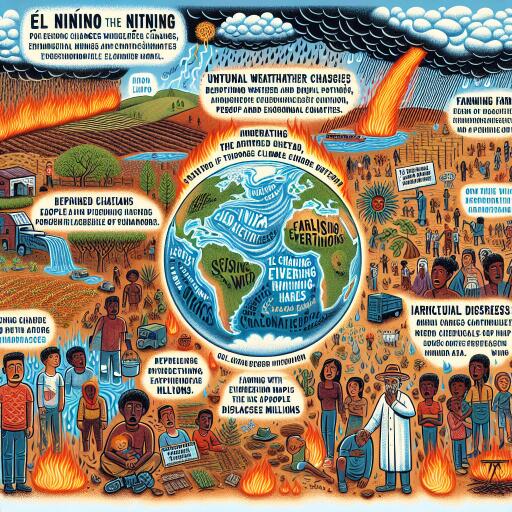
El Niño Worsens Global Climate Challenges with Profound Human Impact
As the world grapples with the escalating climate emergency, the El Niño phenomenon emerges as a formidable catalyst, intensifying existing threats and unleashing a series of devastating environmental impacts. Its current manifestation ranks among the strongest ever recorded, profoundly disrupting global weather patterns and exacerbating the conditions of millions.
In the heart of Southern Africa, a devastating drought has gripped the lives of millions, thrusting a region already teetering on the edge into a fight for survival. Agriculture, the lifeline for 70% of its inhabitants, stands crippled, heralding a crisis of hunger and uncertainty. Meanwhile, nations such as Kenya, Somalia, Burundi, and Tanzania find themselves at the mercy of nature’s fury, with torrential rains and swift floods wreaking havoc on their lands, claiming crops and livestock, and displacing countless families.
Farther afield, Afghanistan has been battered by an onslaught of floods following an unusually dry winter. Come spring, an unexpected deluge, compounded by melting snow, laid waste to villages and livelihoods, leaving over 80,000 individuals in dire straits and leading to the tragic loss of 180 lives. International aid, including efforts by the World Food Programme (WFP), has been pivotal, offering a lifeline through food, fiscal support, and nutritional supplementation.
The dire scenarios unfolding across Southern Africa—with countries like Malawi, Zambia, and Zimbabwe declaring national emergencies due to parching droughts—underscore a reality faced by nearly five million people in desperate need of aid.
Gernot Laganda of the WFP articulates a poignant truth: the climate-induced aspects of hunger and displacement, albeit devastating, are not without predictability. This prescience affords us the means to mitigate their impact, through forecasting and prior protective measures, especially in vulnerable regions often cut off from such critical information and assistance.
The Democratic Republic of the Congo has not been spared, with incessant rains leading to the overflow of rivers and inundation of lands, disconnecting communities, and precipitating food shortages and heightened hunger affecting over a million lives.
The narrative of El Niño intertwines inseparably with the broader climate crisis narrative, each feeding into the other and perpetuating a cycle of extreme weather events. This synergy of chaos does not end with immediate effects but leaves a lingering shadow of vulnerability, exacerbated by conflicts, economic shocks, and other crisis vectors. Looking ahead, even as El Niño may fade into a neutral state by mid-2024, its aftermath will be felt long after, possibly giving way to its counterpart, La Niña.
In response, entities like the WFP, in conjunction with various partners, ramp up efforts to provide emergency assistance while reinforcing government efforts towards more resilient social protection frameworks and nutritional programs. In Malawi, the aim is to reach 2.1 million individuals through a combination of direct aid and cash assistance, facing down the specter of regional cereal shortages.
The importance of anticipatory actions and early warning systems cannot be overstated. Such initiatives have already shown their worth; for instance, in Somalia, ahead of impending floods, over 200,000 people benefited from preemptive cash transfers and alerts. Similarly, in Zambia and Zimbabwe, emergency measures activated by a significant insurance payout ensured nearly 280,000 people could withstand the crisis.
To truly fortify against the ravages of El Niño and climate disturbances, a multifaceted approach is imperative. This approach melds early detection and financial safety nets with nature-based solutions like soil restoration and reforestation, equipping communities not merely to endure but to adapt and thrive in the face of climatic upheavals. The imperative to act is clear: as the planet edges closer to environmental tipping points, the window for effective intervention narrows, underscoring the urgency of a united global response to climate resilience and sustainability.





Leave a Reply